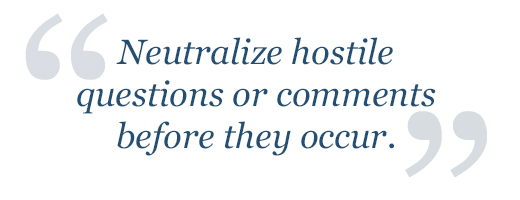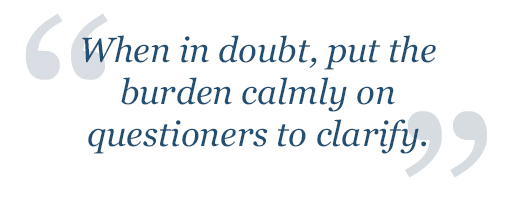As the AdComm meeting proceeded, a panelist became visibly agitated. Finally, interrupting a discussion of sample size, he clicked the microphone on and snarled, "You don't have the guts to run this study!" Audience eyes shifted from the presenter to the panelist and back, uncomfortable, half-fearing that a shouting match would erupt. Time seemed to stand still as the speaker considered his response. The room echoed a stunned silence.
Receiving a hostile question or comment is like catching a ticking bomb. You need to delicately defuse it before it explodes in your face. Broadly defined, hostility includes any query that challenges your narrative – both the way you want to tell it and the conclusions that it demonstrates. In this sense, hostile questions range from innocuous or merely rude interruptions to mild differences of opinion to highly charged challenges.

At the very least, hostile questions divert attention from your messages; at the worst, they shift it from your program to the individual people involved. Either possibility threatens to undermine your messages and your credibility.
The best time to neutralize hostile questions or comments is before they occur. It's generally most effective to raise potentially contentious topics yourself in briefing material and presentations. In those forums you can address them on your own terms, in the appropriate context, and with time to bring all relevant information to bear. You gain credibility and steal the thunder from questioners who might otherwise act as though they are uncovering a skeleton you had buried. Careful audience analysis and searing self-assessment can thus put you ahead of the game before Q&A even begins.
When unexpected hostility erupts, there are several tactics you can employ to calm the storm and return the discussion from feeling to fact. Central to each is fighting fire with ice, directing attention away from hostility by highlighting the core concern without engaging the feelings that accompany it.
When a car skids out of a control, loss of traction allows momentum to take it in an unintended direction. Though a driver's natural instinct is to "fight" the skid by turning more forcefully in the intended direction, the best way to regain control is actually to relinquish it momentarily by turning in the direction of the skid. Do the same when questions or heated objections interrupt you. Your aim is to calmly and confidently restore the logical flow of your argument.
There are four steps to skid control:
1. Maintain the impression of control. Don't be flustered by interruptions; when you express fear through tone and body language, you actually invite more questions.
2. Calmly acknowledge the question or concern expressed ("You are asking about the potential for hepatic toxicity.") Interruptions don't go away by wishing them away or pretending they don't exist. Once made, they are part of the discourse and must be integrated with what you've just said and what you want to go on to say.
3. State your core message briefly. In 25 words or less, offer the headline—but not the substance—of your response to the objection. Show you both understand and take the interruption seriously. This helps reduce any existing tension and earn you some patience.
4. Finally, promise to cover the topic within the presentation. Having moved in the direction of the interruption with that promise, move back in your intended direction by explaining where you will fully address it and why it actually serves the questioner to wait until then. Without asking "is that okay?" bridge back to your presentation.
When it is time to fully address hostile questions in the Q&A session, three additional techniques can help you maintain control.
One way to begin is by acknowledging the questioner's emotion or opinion but then providing context that strengthens your own message. For example: "I hear your concern about potential abuse. As we mentioned, we had no cases of misuse in our clinical studies. Let me explain how our patient education program addresses that risk for the general population." This technique recognizes the feelings or beliefs of the questioner but creates space for you to emphasize information that supports your message.

Identify the Core Issue and Reframe the Question
More generally, it is almost always effective to neutralize charged language. When a question contains inflammatory or emotion-laden terms, pause to identify the issue that prompted it. Then rephrase the question using neutral language that focuses on the real issue. Suppose a questioner accuses, "You are killing children!" You might reframe by saying, "You are asking about pediatric safety and specifically the risk of death. Let me review the two deaths that were judged to be unrelated to study drug."
A related technique is to ask the interlocutor to reframe the question. Always feel free to ask an interlocutor to clarify a question. Often it becomes more direct and concise the second time it is posed. Suppose someone asserts "your safety profile is unacceptable!" In response, you might calmly ask "Which aspect of our safety data concerns you?" Under pressure, you may be tempted to guess and quickly dispel the provocative issue that prompted the hostility. Don't. Doing so may open a new area of concern. When in doubt, put the burden calmly on questioners to clarify.
While we don't recommend evading a question, certain phrases can help you redirect it, usually after a brief direct answer ("I see your point. But I think the real issue is whether there is evidence of elevated risk. The full data set suggests not. In particular…"). Bridging this way acknowledges the questioner's focus without adopting it. Instead, you gracefully redirect the questioner and the entire audience to information that is pertinent and persuasive.
Any one of several phrases can help you bridge from hostile questions to a calm response:
- I think it would be more complete to say that while…
- It's true that…but it is also true that…
- What all this information tells me is…
- This question raises several issues. Let's look at them…
- Let me put all this in perspective by…
- If we look at the full data set, the question becomes…
Overall, remind yourself that most apparent hostility reflects passion about the subject, not contempt for you as a person or company representative. Practicing and then using these techniques will help you, the questioner, and the entire audience return to the topic you all care about. Managing with composure any episode of hostility will not only preserve your credibility but increase it.





